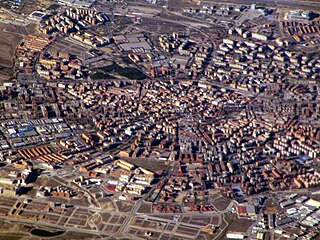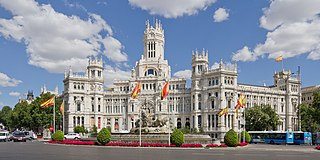
Adolfo Suárez Madrid–Barajas Airport is the main international airport serving Madrid, the capital city of Spain. At 3,050 ha in area, it is the second-largest airport in Europe by physical size behind Paris Charles de Gaulle Airport. In 2019, 61.8 million passengers travelled through Madrid–Barajas, making it the country's busiest airport as well as Europe's fifth-busiest.

The Madrid Metro is a rapid transit system serving the city of Madrid, capital of Spain. The system is the 14th longest rapid transit system in the world, with a total length of 293 km (182 mi). Its growth between 1995 and 2007 put it among the fastest-growing networks in the world at the time. However, the European debt crisis greatly slowed expansion plans, with many projects being postponed and canceled. Unlike normal Spanish road and rail traffic, which drive on the right, Madrid Metro trains use left-hand running on all lines because traffic in Madrid drove on the left until 1924, five years after the system started operating.

Móstoles is a municipality of Spain located in the Community of Madrid. With over 200,000 inhabitants, it is the region's second most populated municipality after Madrid. Móstoles was a small town for a long time, but expanded rapidly in the second half of the 20th century.
Telemadrid is a public television station in the Community of Madrid, Spain, the flagship channel of the regional public broadcaster Radio Televisión Madrid (RTVM). It began its broadcast on 2 May 1989.

Gran Vía is a station on Line 1 and Line 5 of the Madrid Metro, located underneath the Gran Vía and Red de San Luis Plaza in the Centro district of Madrid. It is located in fare zone A.

Madrid is the capital and most populous municipality of Spain. It has almost 3.4 million inhabitants and a metropolitan area population of approximately 7 million. It is the second-largest city in the European Union (EU), and its monocentric metropolitan area is the second-largest in the EU. The municipality covers 604.3 km2 (233.3 sq mi) geographical area. Madrid lies on the River Manzanares in the central part of the Iberian Peninsula at about 650 meters above mean sea level. The capital city of both Spain and the surrounding autonomous community of Madrid, it is also the political, economic, and cultural centre of the country. The climate of Madrid features hot summers and cool winters. The primitive core of Madrid, a walled military outpost, dates back to the late 9th century, under the Emirate of Córdoba. Conquered by Christians in 1083 or 1085, it consolidated in the Late Middle Ages as a sizeable town of the Crown of Castile. The development of Madrid as administrative centre fostered after 1561, as it became the permanent seat of the court of the Hispanic Monarchy.

The 2015 Madrid City Council election, also the 2015 Madrid municipal election, was held on Sunday, 24 May 2015, to elect the 10th City Council of the municipality of Madrid. All 57 seats in the City Council were up for election. The election was held simultaneously with regional elections in thirteen autonomous communities and local elections all throughout Spain.

Madrid is served by highly developed transport infrastructure. Road, rail and air links are vital to maintain the economic position of Madrid as a leading centre of employment, enterprise, trade and tourism, providing effective connections with not only other parts of the region, but also the rest of Spain and Europe as a whole. Three quarters of a million people commute into the city to work, and these and other local travellers have available a high-capacity metropolitan road network and a well-used public transport system based on the Metro, the Cercanías local railways, and a dense network of bus routes.

The 2011 Madrid City Council election, also the 2011 Madrid municipal election, was held on Sunday, 22 May 2011, to elect the 9th City Council of the municipality of Madrid. All 57 seats in the City Council were up for election. The election was held simultaneously with regional elections in thirteen autonomous communities and local elections all throughout Spain.

The 2019 Madrid City Council election, also the 2019 Madrid municipal election, was held on Sunday, 26 May 2019, to elect the 11th City Council of the municipality of Madrid. All 57 seats in the City Council were up for election. The election was held simultaneously with regional elections in twelve autonomous communities and local elections all throughout Spain, as well as the 2019 European Parliament election.

The Consorcio Regional de Transportes de Madrid is an autonomous body created by Spanish law 5/1985 which is tasked with coordinating the public transport operations across multiple providers in the Community of Madrid. It harmonizes fares for commuter rail, rapid transit, light rail and bus transport services provided by entities such as Renfe Cercanías, Metro de Madrid S.A. or the Empresa Municipal de Transportes de Madrid (EMT).

The City Council of Madrid is the top-tier administrative and governing body of the Madrid, the capital and biggest city of Spain.

In Madrid, Metrobús is the name given to the ticket that allows to travel 10 times inside of the bus and Metro system of the city.
The city of Madrid has been increasing in the last years its network of bicycle paths. In 2016, there were 195 km of cycling routes. The former city council had been planning to build 400 km more for the year 2024 despite a very vocal opposition to the construction of segregated infrastructure by a significant part of the local cycling community. However now with the new right wing mayor elected in 2019 the city is set to be the only capital in the world where bicycle lanes are being removed again.

BiciMAD is a bicycle sharing system in Madrid, Spain. It is currently provided by the Empresa Municipal de Transportes de Madrid, a public company owned by the City Council of Madrid.

Carrocera Castrosua, S.A. is a coachbuilder based in Santiago de Compostela, Spain. The production of Castrosua is focused mainly on urban and suburban transport, as well as multi-purpose coaches under the subsidiary brand Carsa.

The 2023 Madrid City Council election, also the 2023 Madrid municipal election, was held on Sunday, 28 May 2023, to elect the 12th City Council of the municipality of Madrid. All 57 seats in the City Council were up for election. The election was held simultaneously with regional elections in twelve autonomous communities and local elections all throughout Spain.
In the run up to the 2015 Spanish local elections, various organisations carried out opinion polling to gauge voting intention in local entities in Spain. Results of such polls for municipalities in the Community of Madrid are displayed in this article. The date range for these opinion polls is from the previous local elections, held on 22 May 2011, to the day the next elections were held, on 24 May 2015.

The Tarjeta Transporte Público is a payment method for public transport in Madrid, the capital of Spain, and its surrounding autonomous community. Managed by the Consorcio Regional de Transportes de Madrid (CRTM), the body responsible for coordinating public transport in the Community of Madrid, as of 2019 more than 16 million TTPs are in circulation.

Transport in Quito, Ecuador consists of a variety of modes.






















